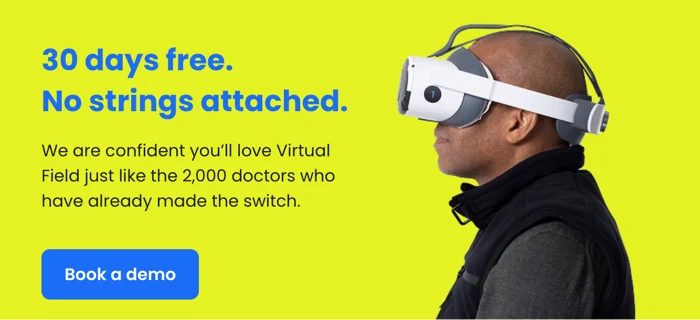Over the past few years, there have been new technological advances in the world of ophthalmology. With virtual reality perimetry (VRP), virtual reality visual field testing has dramatically improved for patients and technicians. This blog post compares and contrasts VRP and tabletop analyzers. It also discusses the benefits of using a VRP and critical factors to consider when choosing a VRP versus a tabletop analyzer.
Virtual Reality Perimeters vs. Tabletop Analyzers
Visual field testing, also called perimetry, detects visual field deficits or blind spots in a person's vision. Perimetry lets ophthalmologists see certain eye conditions, like optic nerve disorders, strokes, and brain tumors. Visual field testing is the gold standard for detecting glaucoma, which can potentially lead to blindness. Many ophthalmologists use automated perimetry devices, like the Humphrey Field Analyzer, to screen and analyze a patient's visual field defects during their annual eye exam.
With technological advances in virtual reality visual field perimetry, some ophthalmologists are hesitant to move from using the standard tabletop analyzers. However, research shows VRP is a reliable testing alternative to tabletop automated devices. Additionally, VRP offers the portability and comfort standard automated perimetry devices lack.
Key Differences Between Virtual Reality Perimeters and Tabletop Analyzers from a Patient’s Perspective
Many patients find VRP devices more comfortable and efficient. Research shows that using a virtual reality headset can improve patient experiences. Patients are not usually intimidated by the virtual headset, unlike the tabletop device, because they are familiar with these types of devices. It does not require exact positioning, so the patient is free to move around in their chair.
In addition, patients often find tabletop analyzers awkward and uncomfortable to sit at since they have to lean forward for several minutes. Tabletop analyzers are often meant for average size adults, and the patient needs to be angled at a particular position for the provider to perform the test accurately. Thus, adjusting the machine and chair to fit a smaller adult’s height can be challenging. In addition, the exam often takes several minutes to perform for each eye, and this can become quite uncomfortable for the patient. If the patient moves, the test can produce inaccurate results and require further testing. Instructions can be difficult to initially understand, especially for patients with cognitive or learning disorders. These challenges can lead to decreased patient satisfaction.
Alternatively, VRP devices are more comfortable than traditional tabletop analyzers since they sit comfortably on the head and patients do not have to lean forward. They are also more readily portable, making it easier to test patients. Some patients cannot visit an ophthalmologist regularly due to transportation, time, or other constraints. A VRP is an alternative for ophthalmologists to use while offering mobile services to their patients. Virtual reality perimetry requires minimal instruction by the technician compared to the tabletop analyzer. This process can make screening for visual field defects in patients with learning disorders easy and reduce the likelihood of inaccurate results. Thus increasing access to care and improving patient satisfaction.
How Virtual Reality Perimeters and Tabletop Analyzers Support Cataract Surgeons and Technicians
Ophthalmologists frequently perform eye procedures like cataract surgery and need the most updated visual field results. By using virtual reality visual field technology, doctors can have the most up-to-date and accurate patient metrics. Information can even be obtained remotely, where the patient is in a different office location than their ophthalmologist. The results automatically upload to the patient’s electronic health record and track results over time. Virtual visual field technology can perform tests like the Esterman, ptosis, and central visual field tests, making it an invaluable resource.
Additionally, virtual reality testing can improve ophthalmic technician retention. They no longer have to continuously instruct patients, reposition machines, and operate the tabletop analyzers, worrying about accurate results.
Factors a Doctor Should Consider When Choosing Between Virtual Reality Perimeters and Tabletop Analyzers
There are various factors a doctor should consider when choosing between a virtual reality perimeter and a tabletop analyzer. Some of these key factors include the following:
- Height: Tabletop analyzers are designed for adults, which can be challenging if the patient is shorter than average. It may be more beneficial to use a VRP headset in cases when the patient is smaller to get accurate results.
- Mobility: Some patients have difficulty leaning forward or mobility challenges like being in a wheelchair. Transferring to a different chair or sitting at a tabletop can be difficult. In these instances, a virtual reality device is a great alternative to a tabletop analyzer.
- Cognitive ability: If a patient has difficulty understanding directions, VRP may make it easier for the technician or doctor to perform visual field testing. VRP requires fewer instructions than a tabletop analyzer and also tells the patient the instructions.
- Eye disorders: Patients with known visual field deficits require frequent monitoring and follow-up. VRP devices help technicians and ophthalmologists easily track small changes in visual deficits. Many VRP devices have progression analysis capabilities, which allows doctors to compare results. Often, tabletop analyzers do not offer this feature, so using a VRP device is more beneficial, especially for patients with glaucoma.
Virtual reality perimetry is a useful and informative alternative to traditional tabletop analyzers. Ophthalmologists often find VRP beneficial since they can easily track and analyze small changes in a patient's visual fields. Thus, VRP allows for more individualized patient care.
About Virtual Field
Virtual Field delivers an exceptional eye exam experience. Eye care professionals including ophthalmologists and optometrists examine patients faster, more efficiently, and more comfortably than ever before. Exams include Visual Field, 24-2, Kinetic Visual Field (Goldmann Perimetry), Ptosis, Esterman, Color Vision, Pupillometry, Extraocular Motility (EOM), and more.


